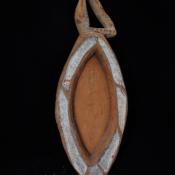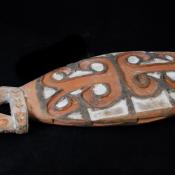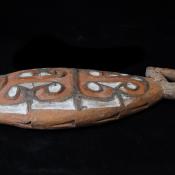This is a wooden sago dish used by the Asmat people of Papua New Guinea. The curved surface of the platter features a symmetrical geometric design using the colors of red, white, and black. Much of the surface has experienced damage over the years, resulting in cracked and faded paint. The sides of the platter feature 12 total triangular designs (6 on each side). The bottom of the platter has been carved with an oval-shaped pit set 1.5” into the wood. The rim of the pit is decorated with symmetrical geometric designs, each painted in white. The handle of the piece is carved in the shape of two birds, a hornbill and a cassowary. The two birds’ beaks meet in the center.
Sago platters performed an important function in ceremonial events and everyday life. They are used to serve roasted balls of sago and are highly decorated. They are made from the wood of the sago tree, one of the primary sources of sustenance and building materials for Asmat communities. The depiction of two birds on the handle of this piece is representative of the emphasis that was placed on the importance of the natural world in providing for the Asmat. Hornbills and cassowaries are commonplace in Papua New Guinea and assume important roles in fertility myths for many Asmat peoples.
Platters such as this were also used for the serving of human brains at meals. This practice was phased out by missionaries who discouraged headhunting raids in the late twentieth century, but legacies of the ritual remain. The ceremonial consumption of the Capricorn beetle, whose larvae strongly resemble human brain matter, is believed to have replaced the consumption of brains as a cultural staple food.
Colors: Brown, Red, Black, White




